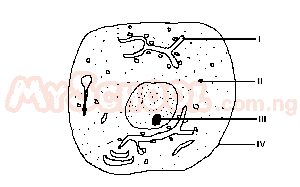Year :
1997
Title :
Biology
Exam :
JAMB Exam
Paper 1 | Objectives
1 - 10 of 49 Questions
| # | Question | Ans |
|---|---|---|
| 1. |
 The structure labelled I is the A. Golgi body B. mitochondrion C. endoplasmic reticulum D. vacuole |
C |
| 2. |
 Protein is synthesized in the part labelled A. I B. II C. III D. Iv |
A |
| 3. |
Which of the following is the youngest plant tissue A. Meristem B. Phloem C. Epidermis D. Xylem |
A |
| 4. |
Viruses differ from all forms of life because they A. have thick cell wall B. feed on waste products of other organisms C. causes infectious diseases D. require other living cells to multiply |
D |
| 5. |
The endoplast cells found in hydra are used for A. reproduction B. offence and defence C. locomotion and nutrition D. food collection |
A |
| 6. |
Annelides differ from nematodas in that they A. exhibits bilateral symmentry B. are triploblastic C. are metamerically segmented D. possess complete digestive system |
C |
| 7. |
Which of the following performs similar functions? A. Ascospores ans ascocarp B. Antherozoids and rhizoids C. sorus and indusium D. Strobili and inflorescence |
C |
| 8. |
In ferns, the sporophyte A. develops from a haploid zygote B. reproduce asexually to produce spores C. is haploid and dependant on gametophyte D. is diploid and independent of the gametophyte Detailed SolutionSporophytes undergo MEIOSIS to form spores. The process of spore formation is asexual reproduction method. |
|
| 9. |
The group of insects that undergoes complete metamorphosis is A. houseflies, beetles and cockroaches B. cockroaches, grasshoppers and bees C. houseflies, beetles and butterflies D. aphids, grasshopper and butterflies |
C |
| 10. |
The nitrogenous substance that is excreted by birds in order to conserve water is A. ammonia B. urea C. uric acid D. nitric acid |
C |
| 1. |
 The structure labelled I is the A. Golgi body B. mitochondrion C. endoplasmic reticulum D. vacuole |
C |
| 2. |
 Protein is synthesized in the part labelled A. I B. II C. III D. Iv |
A |
| 3. |
Which of the following is the youngest plant tissue A. Meristem B. Phloem C. Epidermis D. Xylem |
A |
| 4. |
Viruses differ from all forms of life because they A. have thick cell wall B. feed on waste products of other organisms C. causes infectious diseases D. require other living cells to multiply |
D |
| 5. |
The endoplast cells found in hydra are used for A. reproduction B. offence and defence C. locomotion and nutrition D. food collection |
A |
| 6. |
Annelides differ from nematodas in that they A. exhibits bilateral symmentry B. are triploblastic C. are metamerically segmented D. possess complete digestive system |
C |
| 7. |
Which of the following performs similar functions? A. Ascospores ans ascocarp B. Antherozoids and rhizoids C. sorus and indusium D. Strobili and inflorescence |
C |
| 8. |
In ferns, the sporophyte A. develops from a haploid zygote B. reproduce asexually to produce spores C. is haploid and dependant on gametophyte D. is diploid and independent of the gametophyte Detailed SolutionSporophytes undergo MEIOSIS to form spores. The process of spore formation is asexual reproduction method. |
|
| 9. |
The group of insects that undergoes complete metamorphosis is A. houseflies, beetles and cockroaches B. cockroaches, grasshoppers and bees C. houseflies, beetles and butterflies D. aphids, grasshopper and butterflies |
C |
| 10. |
The nitrogenous substance that is excreted by birds in order to conserve water is A. ammonia B. urea C. uric acid D. nitric acid |
C |